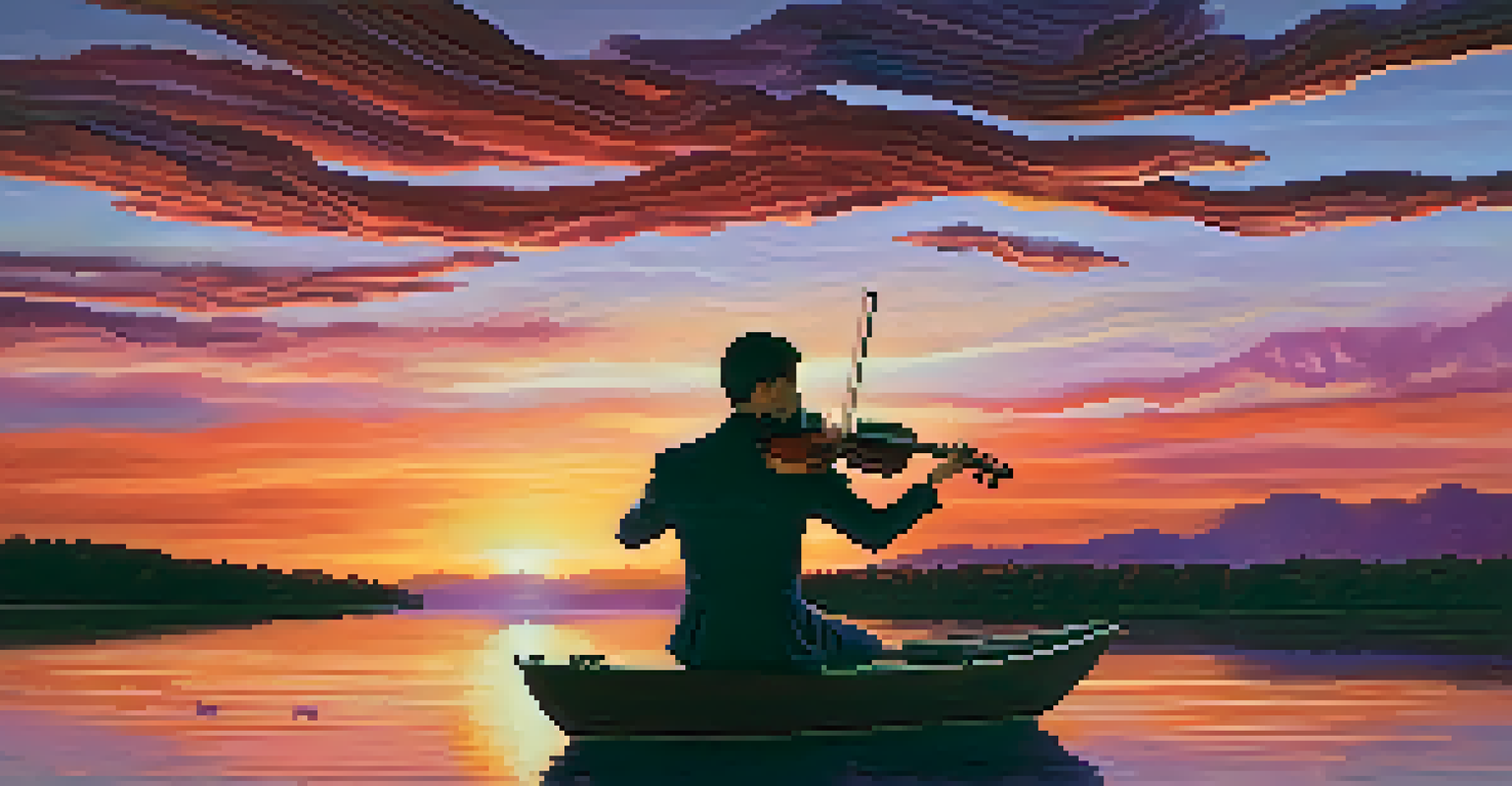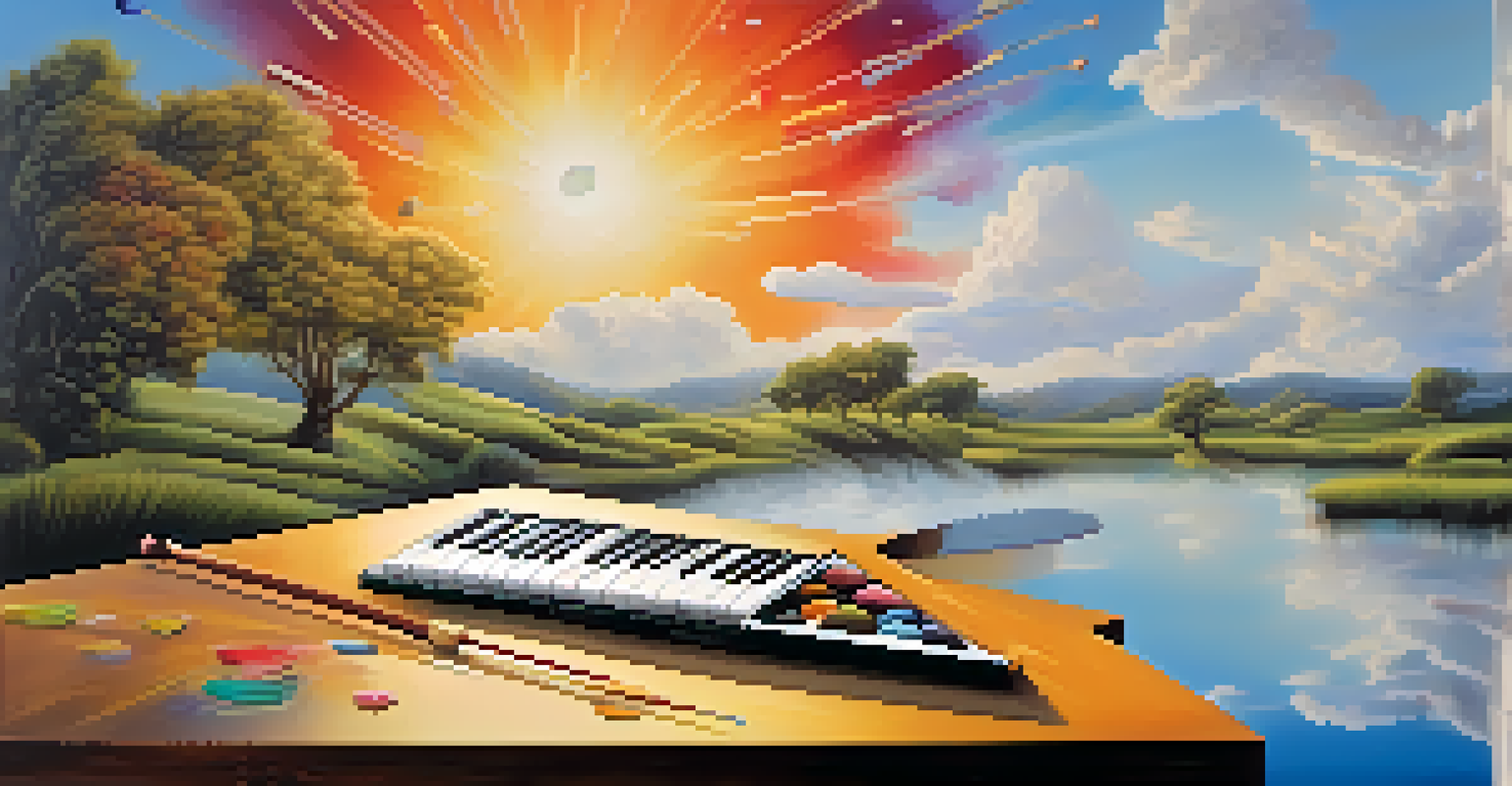The Sound of Color: Painting's Influence on Musical Expression

The Intersection of Visual Art and Music
Throughout history, art and music have been intertwined, each influencing the other in profound ways. Just as a painter uses colors to convey emotions, a musician employs melodies and harmonies to evoke feelings. This connection often leads to a richer experience, where one form of expression enhances another.
Every artist dips his brush in his own soul, and paints his own nature into his pictures.
Consider the Impressionist painters, whose vibrant palettes inspired composers like Claude Debussy. The soft hues of Monet's water lilies can be heard in Debussy's fluid melodies, creating an auditory landscape that mirrors the visual one. This interplay showcases how visual elements can shape musical themes and styles.
By exploring these connections, artists across both mediums can tap into a deeper well of creativity. The blending of colors in a painting can inspire the structure of a musical piece, making the boundaries between art forms feel more porous and dynamic.
Color as a Musical Element
Colors are not just visual; they can also represent sounds in a metaphorical sense. Musicians often describe sounds using color terminology, such as 'bright' or 'dark' tones. This conceptual linking allows artists to convey feelings and moods that transcend words, creating a shared language between disciplines.

For example, the bright yellows and oranges of a sunset might inspire a lively, upbeat melody, while deep blues and blacks could lead to a somber, reflective composition. This phenomenon illustrates how the perception of color can evoke specific emotional responses in music.
Art and Music Enhance Each Other
Throughout history, visual art and music have influenced one another, creating richer emotional experiences.
By interpreting colors through sound, musicians can establish a unique connection with their audience, drawing them into a multi-sensory experience that fosters a deeper appreciation for both art forms.
Synesthesia: A Unique Artistic Experience
Synesthesia is a fascinating condition where stimulation of one sensory pathway leads to automatic experiences in another. For some artists, this means seeing colors when they hear music or associating specific notes with particular shades. This crossover can deepen their creative expression and provide a unique lens through which to view their work.
Music is the shorthand of emotion.
Take the composer Olivier Messiaen, for example, who experienced synesthesia. He often described musical notes in terms of colors, allowing him to create compositions that were as much about visual experience as they were about sound. His work challenges traditional boundaries and invites listeners into a vivid, immersive journey.
This blending of senses not only enriches the artistic experience but also encourages collaboration between musicians and visual artists. When they share their unique perspectives, it can lead to innovative projects that push the limits of both disciplines.
Painting and Musical Scores: A Visual Symphony
The visual representation of music can take many forms, including illustrated scores or interpretive paintings inspired by compositions. These artworks can serve as visual cues, helping audiences to understand and connect with the music on a deeper level. The act of visualizing sound can transform a concert experience into a multi-dimensional event.
For instance, a conductor might use vibrant colors in their score to indicate different dynamics or emotional shifts throughout a piece. This visual element enhances the performance, allowing musicians to draw upon the colors to inform their playing.
Synesthesia Fuels Creativity
The unique condition of synesthesia allows some artists to blend sensory experiences, leading to innovative artistic expressions.
By integrating painting techniques into musical scores, composers can create a more engaging experience for performers and listeners alike, illustrating how interconnected these art forms truly are.
Emotional Resonance: How Art Shapes Feelings
Both painting and music have the power to evoke strong emotions, but how they do so can vary widely. While a painting can capture a moment in time, a piece of music unfolds over time, creating an emotional journey. This dynamic can lead to a more profound exploration of feelings, as listeners are led through a narrative crafted by sound.
Consider a film score that complements the visual storytelling of a movie. The music amplifies the emotional stakes, guiding viewers through moments of joy, tension, or sorrow. In this way, the visual and auditory elements work together to create a cohesive emotional experience.
When artists from different disciplines collaborate, they tap into a shared emotional language that resonates with audiences. This synergy can lead to powerful, memorable experiences that linger long after the final note or brushstroke.
The Influence of Culture on Artistic Expression
Cultural backgrounds play a significant role in shaping how artists express themselves through color and sound. Different cultures have unique associations with colors and musical scales, which can influence how artists interpret their experiences and emotions. This cultural lens enriches the artistic landscape, creating a diverse tapestry of expression.
For instance, in many Eastern cultures, the color red symbolizes luck and happiness, while in Western cultures, it can signify passion or danger. Composers might incorporate these cultural nuances into their work, crafting melodies that reflect their heritage and resonate with listeners from similar backgrounds.
Cultural Influences Shape Expression
Cultural backgrounds significantly impact how artists interpret colors and sounds, enriching the diversity of artistic expression.
By embracing these cultural influences, artists can create works that speak to a wider audience, fostering understanding and appreciation across different backgrounds. This cultural exchange can lead to innovative collaborations that blend various artistic traditions.
The Future of Art: Blending Sound and Color
As technology continues to evolve, the boundaries between visual art and music are becoming increasingly blurred. Virtual reality, augmented reality, and multimedia installations are paving the way for new forms of artistic expression. These innovations allow for immersive experiences that engage multiple senses, creating a more holistic approach to art.
Imagine walking through a gallery where each painting triggers a unique musical composition, or attending a concert where the lighting and visuals change in response to the music. These experiences can captivate audiences, drawing them deeper into the artistic narrative.

As we look to the future, the collaboration between painters and musicians will likely grow stronger. By embracing new technologies and exploring the connections between sound and color, artists can continue to create profound and engaging works that resonate with audiences around the world.